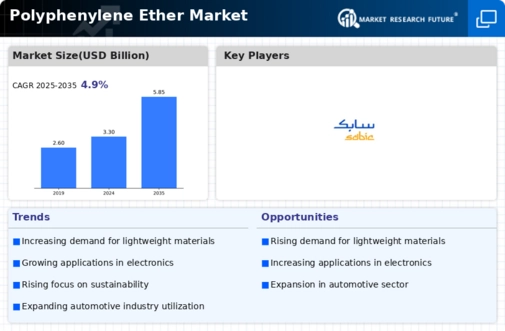Market Share
Polyphenylene Ether PPE Market Share Analysis
Market share positioning strategies in the Polyphenylene Ether (PPE) market involve several key approaches aimed at securing a competitive advantage and capturing a larger portion of the market. One prominent strategy revolves around product differentiation. Companies within the PPE market often focus on developing unique formulations or variations of PPE that offer distinct advantages over competitors' offerings. This could include enhancing properties such as heat resistance, mechanical strength, or chemical resistance, catering to specific industries or applications where these characteristics are highly valued.
The growth of the Polyphenylene Ether Market is driven by the growing use of PPE over steel in automobiles to reduce weight and enhance fuel efficiency.
Another crucial aspect of market share positioning in the PPE market is establishing strong relationships with key customers and stakeholders. This involves understanding their specific needs and requirements and providing tailored solutions that address them effectively. By cultivating close partnerships with major players in industries like automotive, electronics, and aerospace, PPE manufacturers can secure long-term contracts and gain a significant foothold in these lucrative markets.
In addition to product differentiation and customer relationships, pricing strategy plays a vital role in market share positioning. PPE is often used in high-performance applications where quality and reliability are paramount, allowing manufacturers to command premium prices for their products. However, companies must strike a balance between pricing and value to remain competitive in the market. Offering competitive pricing relative to the perceived value of their products can help attract price-sensitive customers while still generating healthy profit margins.
Moreover, effective marketing and branding are essential for establishing a strong market position in the PPE industry. Companies need to invest in promoting their products and communicating their unique selling propositions effectively. This could involve participating in industry trade shows and exhibitions, advertising in relevant publications, or leveraging digital marketing channels to reach target audiences. Building a strong brand identity around quality, reliability, and innovation can help differentiate a company's offerings and resonate with customers in the market.
Furthermore, strategic alliances and partnerships can be instrumental in expanding market reach and enhancing competitiveness in the PPE market. Collaborating with complementary businesses or suppliers can provide access to new markets, technologies, or distribution channels, allowing companies to leverage each other's strengths and capabilities for mutual benefit. Joint ventures, licensing agreements, or strategic acquisitions can also be effective means of consolidating market share and expanding market presence.
Lastly, continuous innovation and investment in research and development are critical for maintaining a competitive edge in the dynamic PPE market. By staying ahead of emerging trends, technological advancements, and evolving customer needs, companies can develop innovative solutions that offer superior performance and value compared to existing alternatives. This proactive approach to innovation not only strengthens market positioning but also fosters long-term sustainability and growth in the highly competitive PPE market.




Leave a Comment